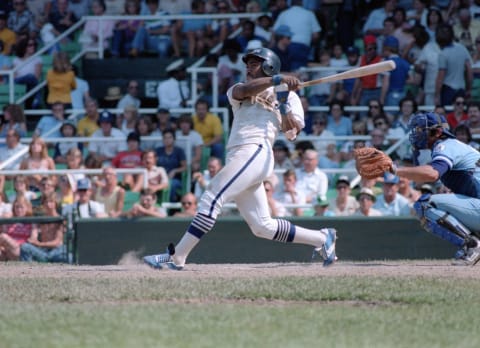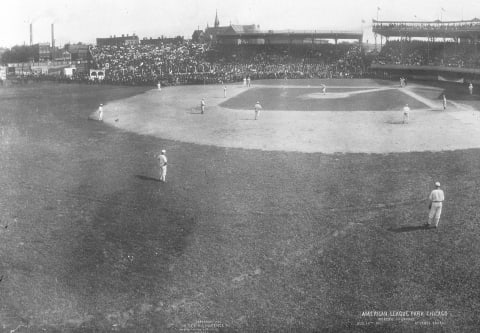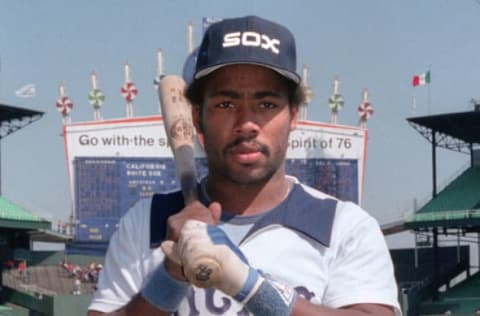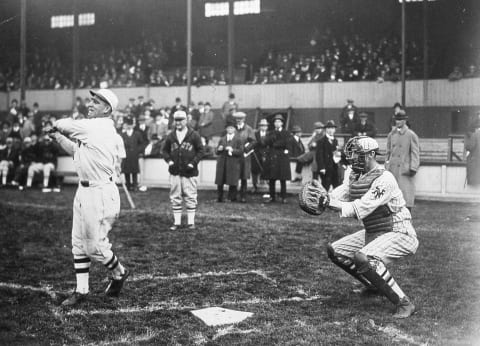White Sox: The Mount Rushmore of center fielders


We complete our trip around the diamond with the four center fielders to memorialize on a Chicago White Sox Mount Rushmore at the position. We’ll conclude the series with the four best utility players.
The White Sox haven’t had a center fielder selected for the Hall of Fame but that doesn’t mean there have not been some outstanding ones.
The qualification line was a player had to have played at least half of his games with the White Sox at the position while compiling 1,500 plate appearances. There were 17 that made the cut:
Related Story. Mount Rushmore of White Sox right fielders. light
- Ken Berry (1962-70)
- Ping Bodie (1911-14)
- Alejandro De Aza (2010-14)
- Adam Eaton (2014-16)
- Happy Felsch (1915-20)
- Ken Henderson (1973-75)
- Lance Johnson (1988-95)
- Fielder Jones (1901-08)
- Mike Kreevich (1935-41)
- Jim Landis (1957-64)
- Rudy Law (1982-85)
- Chet Lemon (1975-81)
- Johnny Mostil (1918, 1921-29)
- Alex Rios (2009-13)
- Aaron Rowand (2001-05)
- Chris Singleton (1999-2001)
- Thurman Tucker (1942-44, 1946-47)

Mount Rushmore of White Sox center fielders: Happy Felsch
Our first face for the Mount Rushmore is a controversial one, the third selection from the players banned for life after allegedly throwing the 1919 World Series. But Happy Felsch was a terrific center fielder for the Chicago White Sox, with above-average power and solid defense.
The White Sox acquired Felsch from the Milwaukee Brewers of the American Association in August 1914, giving up a minor-leaguer named Andrew Slight and $12,000.
Felsch, a Milwaukee area native, was the primary source for Eliot Asinof’s book “Eight Men Out” that later became a movie detailing the Black Sox scandal, according to the Society for American Baseball Research.
He made the opening-day roster in 1915 and settled into center field almost immediately. He came into his own in his second season, hitting .300 with a .768 OPS to go with seven homers and in 1917, Felsch drove in 99 runs for the eventual World Series champs. In the Series victory over the New York Giants, he hit .273 with a home run.
Felsch appeared in only 52 games in 1918, leaving the team got 12 days in may to visit his brother, who had been seriously injured, at a Texas Army base. He came back to the team, but left again on July 1. About three weeks later, Felsch said he wanted to go back to the American League with any team but the White Sox.
He cited disputes with team owner Charles Comiskey over his pay, abstinence from drinking and the reaction to his Texas trip, as well as a conflict with second baseman Eddie Collins. But Felsch returned in 1919, hitting .275 with a .764 OPS and seven home runs. His 24 home runs in the 1910s were the most for the franchise.
Felsch struggled against the Cincinnati Reds, intentionally or not, hitting .192 with three RBI in the eight-game loss. His 1920 season was the best of his career as he hit .338 with a .923 OPS, 40 doubles, 15 triples, 14 homers and 115 RBI before he — like the other seven Black Sox still on the roster — was pulled from the team on Sept. 28.
In six years with the White Sox, Felsch hit .293 with a .774 OPS in 749 games and 3,135 plate appearances, adding 135 doubles, 64 triples and 38 homers. He drove in 443 runs and scored 385, with 88 steals and 86 sacrifice hits.
After being banned from the majors, Felsch played in Montana and Canada until 1930 and it wasn’t until the 1960s that he opened up about the events of 1919. He died in August 1964 at the age of 72.

Mount Rushmore of White Sox center fielders: Fielder Jones
Fielder Jones was a stand out for the Chicago White Sox in their earliest days, jumping from the National League’s Brooklyn Superbas (later the Dodgers) to the White Sox for their inaugural season in 1901. According to legend, Clark Griffith — pitcher and part owner of the new team — walked three miles through the snow in upstate New York to reach Jones’ home.
Jones hit .311 as the White Sox won the first American League pennant and topped the .300 mark again in 1902. In 1904, Jones became player-manager for Chicago, taking over from Jimmy Callahan in early June and guiding the White Sox to a 66-47 finish. They were 89-65 overall and placed third.
Chicago finished two games in back of the Philadelphia Athletics in 1905, with Jones managing and manning center field, but won the pennant in 1906. Nicknamed the “Hitless Wonders,” the White Sox were last in the American League with a .230 average and hit only seven homers, but won the pennant by three games over the New York Highlanders (later the Yankees).
They went on to beat the Chicago Cubs in six games in the World Series, though Jones hit just .143 in the series.
Comiskey did little to improve the club and Jones, who dragged under-talented teams to third-place finishes in 1907 and 1908, quit after that season. Comiskey tried for years to bring Jones back and didn’t release his rights as a player until 1913, when Jones was 42.
Jones later managed in the short-lived Federal League with the St. Louis Terriers and also managed the St. Louis Browns in 1916-18, though he quit after the Browns blew a five-run lead in the ninth inning of a game on June 12, 1918.
As a player for the White Sox, Jones was a terrific baserunner and center fielder. He also hit .269 with a .683 OPS in 1,153 games and 5,107 plate appearances over eight seasons. Jones had 375 RBI, scored 693 runs and stole 206 bases. Jones led the American League with 36 sacrifice hits in 1904.
In retirement from baseball, Jones settled with his family in Portland, Oregon, and died from heart disease in March 1934 at age 62.

Mount Rushmore of White Sox center fielders: Chet Lemon
The Chicago White Sox landed Chet Lemon when he was a Triple-A outfielder in the Oakland A’s organization, acquiring him in as part of a four-player deal at what was then the June 15 trade deadline in 1975. Lemon finished the season at the White Sox Triple-A affiliate in Denver and got a cup of coffee in the show in September.
In 1976, Lemon emerged as the regular center fielder for the White Sox. He was a solid run producer, an excellent defender and represented Chicago in the All-Star Game in both 1978 and 1979.
He led the American League with 44 doubles in 1979, the same year he led the league by getting plunked 13 times. In 1981, he was hit 13 times to again lead the AL, this time in a strike-shortened season during which he played in just 94 games. Ouch.
In November 1981, the White Sox dealt Lemon to the Detroit Tigers in a straight-up swap for former All-Star left fielder Steve Kemp, who played one season in Chicago before bolting via free agency.
Lemon went on to win a World Series with Detroit in 1984, retiring after the 1990 season. In the spring of 1991, he spent nearly three months in the hospital with polycythemia vera, a blood disorder, but he recovered, later founding the Chet Lemon School of Baseball in central Florida.
In parts of seven seasons with the White Sox, Lemon hit .288 with an .814 OPS in 785 games and 3,198 plate appearances. He hit 73 homers with 348 RBI and scored 403 runs, while recording 178 doubles.
The A’s took Lemon, a Los Angeles native, with the 22nd overall pick in the first round of the 1972 draft from Pepperdine University.

Mount Rushmore of White Sox center fielders: Johnny Mostil
Johnny Mostil was a product of the Chicago sandlots in the early 20th century and lived out any kid’s fantasy when he was plucked off one of those playgrounds, driven to Comiskey Park for a tryout and signed to a contract with the Chicago White Sox. Mostil spent the entire 1918 season on the big-league roster, though he played in only 10 games.
He then spent the next two seasons playing for Double-A Milwaukee, thus avoiding any complications with the 1919 World Series scandal. He returned to the majors in 1921, replacing the banned Happy Felsch in center field, but was limited to 100 games due to injuries.
But Mostil hit .301 that season and would top the .300 mark three times in the next five seasons, leading the American League in 1925 with 135 runs scored, 43 stolen bases and 90 walks. In 1926, he led the league with 35 steals and finished second in the MVP voting after hitting .328 with an .882 OPS.
But by 1927, things were tough for Mostil. Wracked by dental pain and neuritis, an inflammation of the nerves, Mostil was in pain almost constantly. Arriving in Shreveport, Louisiana, for spring training, he was treated for the dental problems, but was hit in the chest with a ball during his first round of batting practice.
The next day, after practice was cancelled by rain, Mostil attempted to take his own life at the team’s hotel. He recovered from his wounds to play in 13 games late in the season and returned to full-time duty in 1928. In May 1929, he tripped over home plate while executing a double steal and never played in the majors again.
He wasn’t done with baseball, not by a long shot. Mostil played another 12 seasons in the minor leagues, finishing up with a couple of appearances with Waterloo in the Class-B Illinois-Indiana-Iowa League in 1942, at the age of 46.
Later, Mostil was a White Sox scout for nearly two years, retiring in 1969. He died a little more than a year later, in December 1970, at the age of 74.
Next. All-time White Sox All-Star team. dark
In parts of 10 seasons with the White Sox, Mostil hit .301 with an .812 OPS in 972 games and 4,103 plate appearances, hitting 209 doubles and 82 triples. He scored 618 runs, drove in 375 and stole 176 bases.